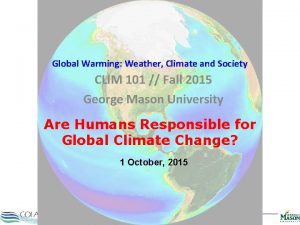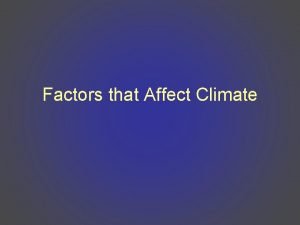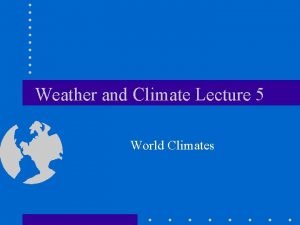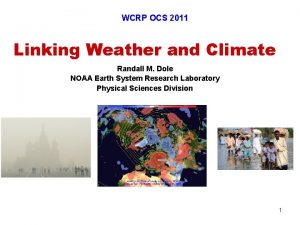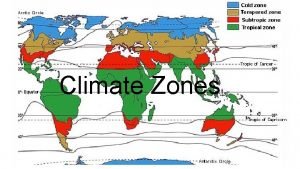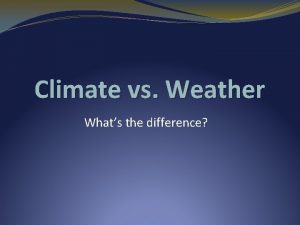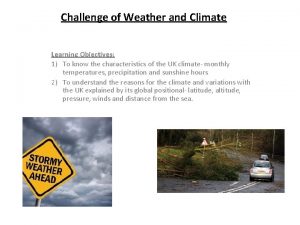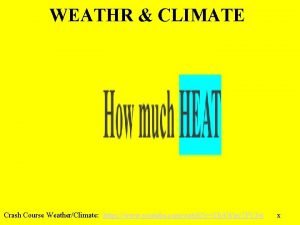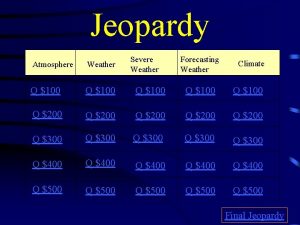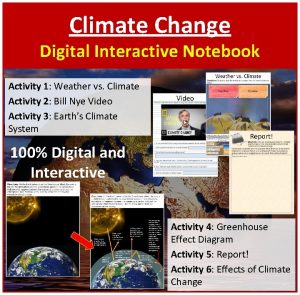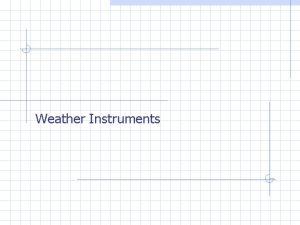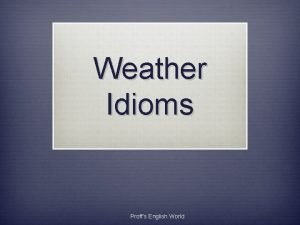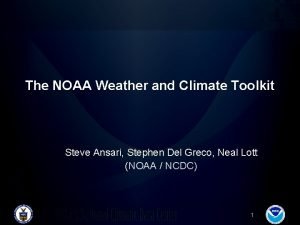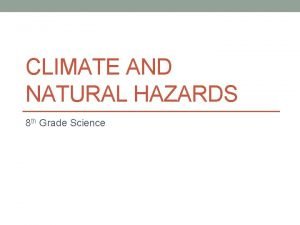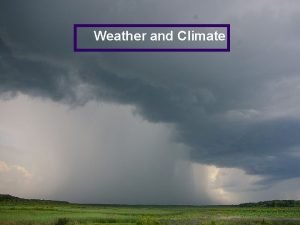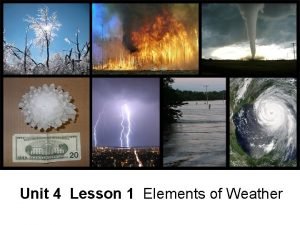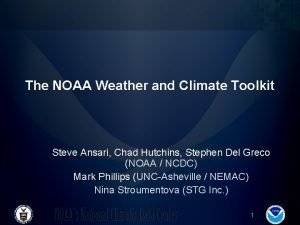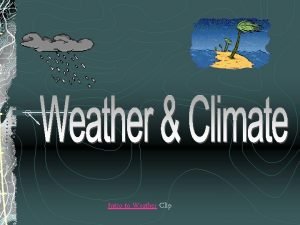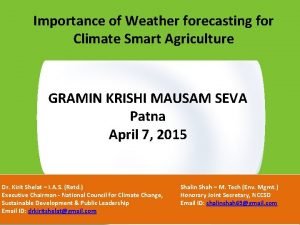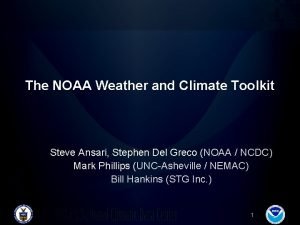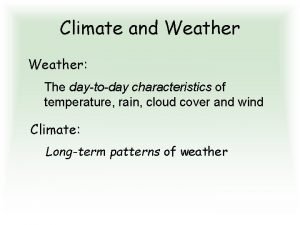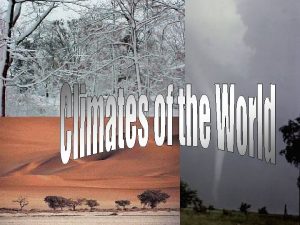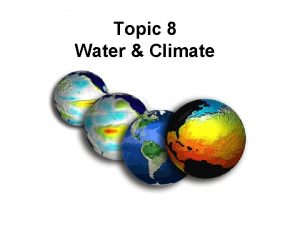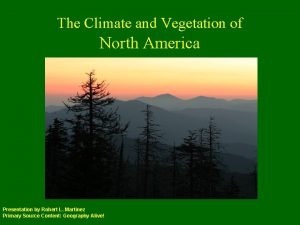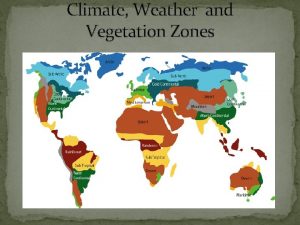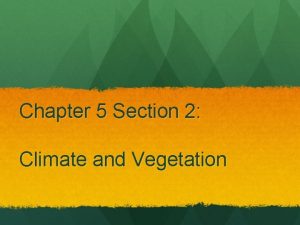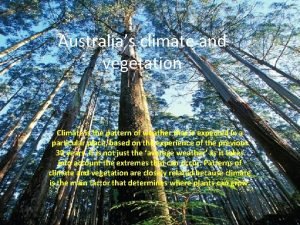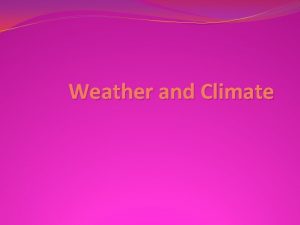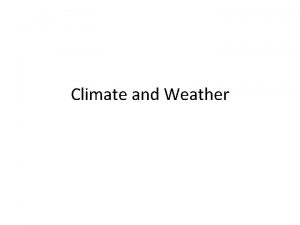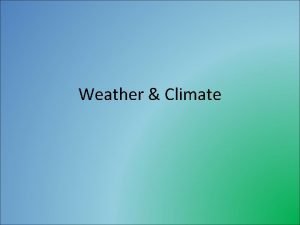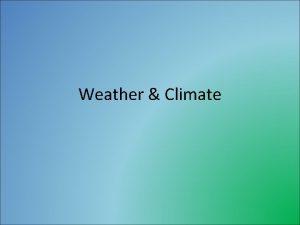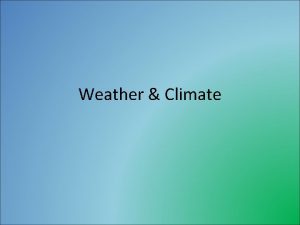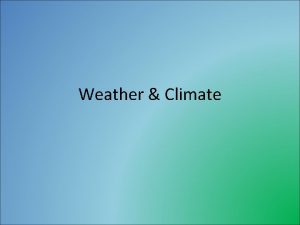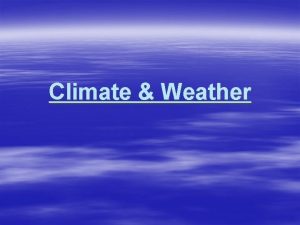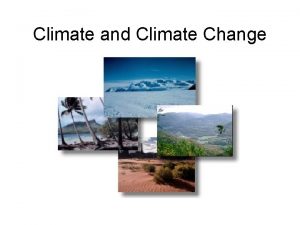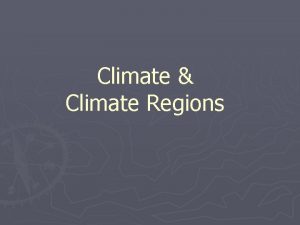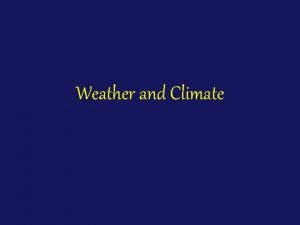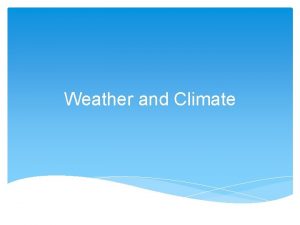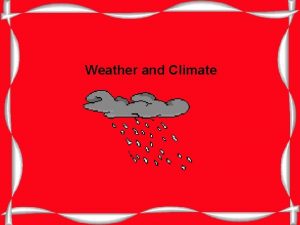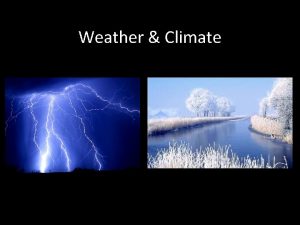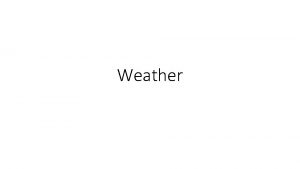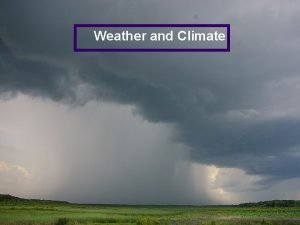Weather and Climate Weather and Climate l How














































- Slides: 46

Weather and Climate

Weather and Climate l How many people know what the weather is going to be the next three days? l How do you know? l Can you predict the weather?

Weather and Climate l l Tip: Start watching the weather reports in the news, looking at the weather reports in the paper and checking online.

Weather and Climate l Why is it important to study the weather?

Unit 1: Weather and Climate l l Task 1: What is the difference between weather and climate? (2 minutes to discuss)

Unit 1: Weather and Climate l l Weather: The state of the atmosphere at any given time. (Look out the window and view the weather) Climate: The atmosphere of an area recorded over a given time period (often 30 years)

Weather Elements: l Write down as many different weather elements that you can remember. l Hint: temperature is one.

Weather Elements: Precipitation Temperature Wind Speed Wind Direction Sunshine Humidity Cloud Cover Air Pressure Visibility

Recording the weather l As well as knowing all of the elements of the weather you must also know how we record each one. l How do we record the weather?

Recording the weather The name of each weather recording instrument. l What the measure. l The unit that they measure in. l

Instrument: Sunshine recorder What does it measure: Hours of Sunshine What unit does it measure in: Hours

Instrument: Rain Gauge What does it measure: Precipitation What unit does it measure in: mm

Instrument: Anemometer What does it measure: Wind speed What unit does it measure in: MPH

Instrument: Wind vain What does it measure: Wind direction What unit does it measure in: Compass points (N, S, E, W)

This also measures humidity Instrument: Stevenson Screen What does it measure: It houses thermometers to measure air temperature. What unit does it measure in: °C

Location of a weather station For each of the following site write down the positives and negatives of each.

Fieldwork: l l l l l Things to remember. The weather station must have: A Stevenson screen A Barometer A Anemometer A Wind vane A Sunshine recorder A Rain Gauge You must think about all of these when you are picking the site.

Factors that influence the weather. l l l Latitude Altitude Proximity to sea Ocean currents Rainshadow Aspect

l l Latitude: The suns rays are most concentrated at the equator, and they have less of a distance to cover here too. This means the closer to the equator you are the hotter it will be. The further you are the colder it will be.

l l l Altitude: The higher up you are the colder it is. For every 100 m you climb it goes down roughly 6°C. This is called the lapse rate. 0. Very cold due to massive height

l l l Proximity to the sea The sea cools down and warms up slower than the land. This means it helps keep places close to the sea cool in the summer and warmer in the winter. Stays cool in the summer and warm in the winter. Land heats and cools much more quickly than the sea.

l l Ocean currents can cool or warm the land. The UK is kept warm due to the North Atlantic Drift (or Gulf Stream) coming from S. American water. Thermal images show the warm current

l l l Rainshadow The Rainshadow is caused due to areas of high land. The moist air from the sea is blown over mountains and therefore many clouds are formed, and there is lots of rain. This means that the area after the mountains will have a dry period. This is known as the rainshadow. Copy this diagram

l Aspect – in the northern hemisphere south facing slopes receive more sunshine than north facing slopes. North facing slopes are in the shade and so will be colder than south facing slopes. Snow tends to last longer on north facing slopes. North: This will be cooler in the northern hemisphere South This will be warmer in the northern hemisphere

Air masses Arctic Maritime l Air masses also affect the weather greatly. l The UK is affected by 5 main air masses.


Air masses l This may seem complicated but it is Polar = cold actually pretty easy. Tropical = hot Maritime = wet Continental = dry l You just have to know what each word means, and it is easy to work out.

Air masses l Now just add them together. l Polar continental = Cold and dry weather l Polar maritime = Cold and wet weather l Tropical continental = l Tropical maritime = l Arctic = Hot and dry weather Hot and wet weather. Extremely cold weather



Stevenson Screen: l You have been given a handout with a diagram of a Stevenson Screen on it. l You must explain why it has each of it’s features.

Inside the Stevenson screen l What is inside a Stevenson screen? l Maximum and minimum thermometer. l Wet and dry bulb thermometer. (to measure humidity)

Sloped roof Painted White Slated sides 1 m long legs Placed on grass

Stevenson Screen: homework l l l Features: Why does it have each of these features? 1 m long legs. Placed on grass. Slanted roof. Slats in the side of the main box. Painted white.

l l l Final task: Get packed away, then…. . Tell the person next to you 5 things you know about the weather topic.

Weather l l l Depressions are low pressure systems. These affect the UK for much of the year. These bring cloud, rain, wind and generally unsettled conditions.

Depressions – how are they formed? l l l Depressions form where warm air meets cold air The boundary between the two air masses is called a front Along a front there will usually be thick cloud and heavy rain

A Depression Cold Front Warm Front



Passage of a depression

Living graph of a depression. l Copy the diagram on the white board then place the numbers on it: l l 1. Weather getting warmer with only a little drizzle. 2. Weather for T-shirt, shorts and sun glasses. 3. Warm clothes but you can leave the umbrella at home. 4. Umbrella and wellies needed! Warm clothes too.

Anticyclones – high pressure

High pressure synoptic chart l l l The word high is written in the middle of the high pressure area The isobars are widely spaced The value of the isobars get higher towards the centre of the anticyclone

Anticyclone weather - Summer l l l Dry and hot days with little or no cloud. Early morning dew and mist. Nights are cool due to lack of cloud during the day.

Anticyclone weather - Winter l l l Fog that may last all day. Mostly clear skies. Frost in the mornings. Freezing nights. Dry.
 Climate change 2014 mitigation of climate change
Climate change 2014 mitigation of climate change How does wind affect weather and climate
How does wind affect weather and climate Clim 101
Clim 101 What is this
What is this Weather and climate similarities
Weather and climate similarities Conclusion of weather and climate
Conclusion of weather and climate Climate zones and weather worksheet answer key
Climate zones and weather worksheet answer key Whats the difference between weather and climate
Whats the difference between weather and climate Objectives of weather and climate
Objectives of weather and climate Weathr today
Weathr today Latitude climate zones
Latitude climate zones What causes warm air to rise brainpop
What causes warm air to rise brainpop Weather and climate jeopardy
Weather and climate jeopardy Weather and climate interactive activities
Weather and climate interactive activities Instruments used to measure weather and climate
Instruments used to measure weather and climate Idioms about weather and climate
Idioms about weather and climate Short poem about seasons
Short poem about seasons Noaa toolkit
Noaa toolkit Bill nye weather and climate worksheet
Bill nye weather and climate worksheet L
L Kahoot quiz
Kahoot quiz Elements of weather lesson plan
Elements of weather lesson plan Weather and climate toolkit
Weather and climate toolkit Brainpop weather
Brainpop weather Contingent crop planning slideshare
Contingent crop planning slideshare Similarities of parallel and series circuits
Similarities of parallel and series circuits Noaa wct
Noaa wct What is the red line on a climate graph
What is the red line on a climate graph Climate vs weather
Climate vs weather Weather station model examples
Weather station model examples Tongue twister about weather
Tongue twister about weather Its stormy
Its stormy Whether the weather is fine or whether the weather is not
Whether the weather is fine or whether the weather is not Heavy weather by weather report
Heavy weather by weather report Capital weather gang weather wall
Capital weather gang weather wall Canada's 7 vegetation regions
Canada's 7 vegetation regions Infiltration water cycle
Infiltration water cycle Vegetation of north america
Vegetation of north america Scandinavian climate and geography
Scandinavian climate and geography Which colonial region contained rocky soil and cold climate
Which colonial region contained rocky soil and cold climate Climate and vegetation zones
Climate and vegetation zones Climate change meaning and definition
Climate change meaning and definition Chapter 5 section 2
Chapter 5 section 2 Why is the middle east so dry
Why is the middle east so dry Australia climate and vegetation
Australia climate and vegetation Chapter 13 atmosphere and climate change section 1
Chapter 13 atmosphere and climate change section 1 Land and climate
Land and climate


